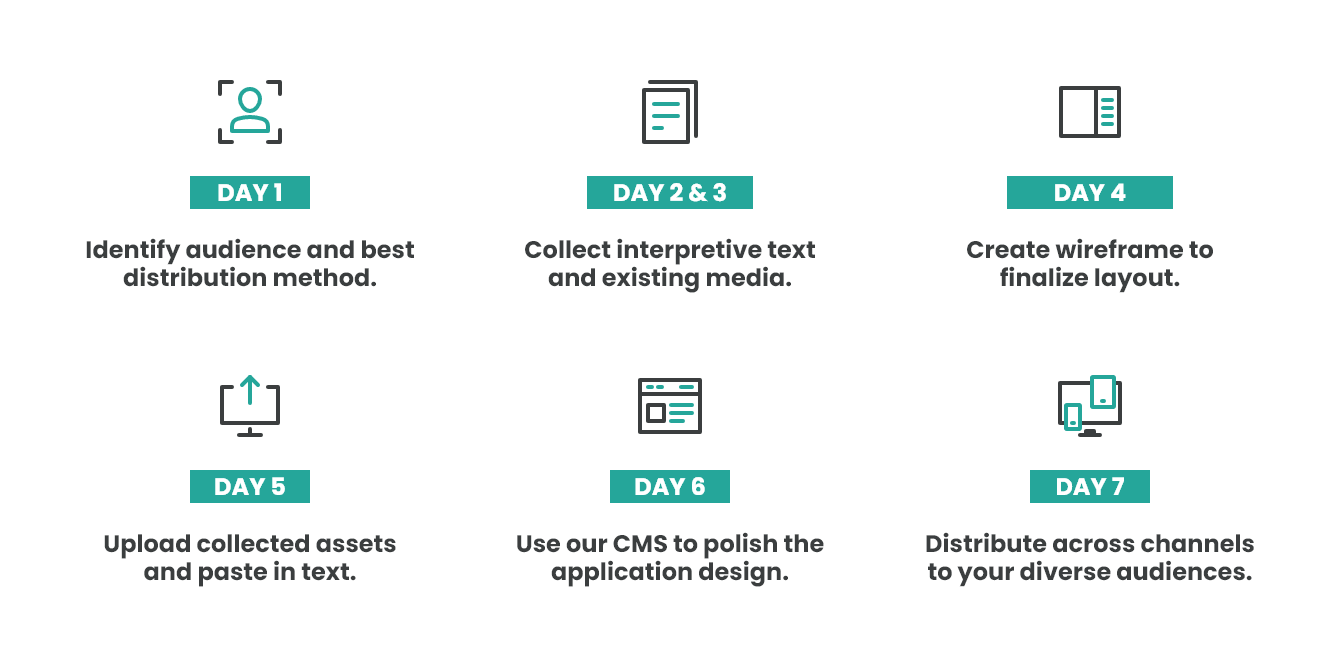
What You Can Do in 7 Days & 30 Days
We’ve talked with dozens of museums seeking virtual solutions for canceled field trips, public programming, and exhibitions access. Many asked “what can I launch right now?” and “how can I be thoughtful and fast while tying into my long-term digital presence?”
In response, we’ve developed 7-day and 30-day guides for creating and launching web-based interactive digital experiences. At the end, we provide a script for ‘turning a crisis into a plan’ at your institution.
THE 7-DAY PLAN
This kind of rapid response is not business as usual, just faster. Decision makers are limited to the most essential, editing and revisions are minimized, and visionary project scopes are reduced to what’s most critical and achievable. Less is more.
What are the essential people, tasks, and assets needed for the activities on each day?
Day 1: Identify your target audience or community and how you will reach them. Perhaps this will be 5th grade educators that you will reach via your existing contact list from cancelled field trips this spring? Or, typical attendees of your rotating exhibitions that you will reach via social media and your membership mailing list. The key is that it is specific and actionable.
Days 2 & 3: Gather your content assets (images, audio, video, text) with an emphasis on leveraging what you’ve got (see our guide to rapid content development LINK). Rather than starting with a broad content strategy and developing content from there, we suggest taking quick stock of your assets and seeing how you can leverage them to fulfill the needs of the audience you’ve identified in Day 1.
Day 4: Create wireframes to finalize the site map and page layouts (sketching with pen and paper is good enough! Or use our wire-framing toolkit). This is where you’re deciding how to organize your content into a story and determining where the content will live on each page. Taking a day to do this will save you time, edit rounds, and reduce confusion when you get to building.
Day 5: Build your app framework (create the pages and load all your content) in your content management system (whether it’s your website or CultureConnect’s platform). Focus on getting the assets where they need to be and confirming the overall story flow. Don’t focus on making it pretty just yet!
Day 6: Focus on look and feel (fonts, colors) and polishing the app. Essential stakeholders should provide final input for minor edits if needed. If you’re not checking in daily with the project approver, the best checkpoints for buy-in are on Day 1 and Day 4.
Day 7: Focus on launching. This includes hitting the publish button as well as executing on your distribution plan established on Day 1. Compose and send that email to educators or members, execute on social media.
The following week: Review your process with the team – acknowledge what went well and what could be done differently. See how the application is performing and if your distribution channels were effective. Determine your next set of priorities and if another 7-day plan or a 30-day plan is the next best step.
IDEAS FOR WHAT YOU CAN DO IN 7 DAYS
Build a Family Experience using your existing mobile guide. We’ve had clients like the Alexandria Museum of Art craft family tours as part of their standard mobile guide. Expand your mobile guide content to speak directly to families observing social distancing that are stuck at home.
Transform physical experiments and onsite activities into at-home experiments. Share materials, instructions, and perhaps even an instructional video of your team working through the experiment.
For more ideas, check out our guide for getting education and public programs online right now.
THE 30-DAY PLAN
While 30 days is much longer than 7 days, it’s still a time crunch that comes with urgency. This expanded timeline offers the potential to create a plan based on more nuanced priority and expands the number of projects that can be tackled with participation across departments.
Week 1: Identify all projects that need a virtual presence including exhibitions, fundraising events, educational programming, and any other high priority programming that your museum offers.
- Assign a priority to each project. We like the MoSCoW method (Google it or check out our digital project planning tool).
- Identify project stakeholders. If your high priority projects have largely separate stakeholders, your team is in the lucky position of being able to tackle multiple high priority projects at once.
- Get approval for high priority projects.
- Establish your project timeline and important milestones.
- Assign roles and responsibilities. We use a stakeholder matrix for all our customer projects.
- Identify the core content you’ll need to bring the project to fruition.
- Determine potential marketing and distribution channels.
Early Week 2: Project leaders take this time to finalize their content strategy, identify project obstacles and possible solutions, identify their support team and share these findings with leadership for final sign off.
- Confirm your content strategy (media asset type(s), story flow, high level page layouts) aligns with readily available solutions and tools. If not, adjust your content strategy within the parameters of what is available or can be created quickly.
- By identifying your obstacles immediately, you give your team ample time to move through asset requests, permissions processes, and/or develop brand new content that will need to pass through your institution’s approvals.
- Assign leaders to each obstacle so that there is a clear owner to help drive this obstacle to a resolution early enough to launch your project successfully or find a replacement.
- Kickoff content development!
- Refine the marketing and distribution plan.
Week 2 – Week 3: Work, work, work
- Give your team two full weeks to develop their ideas and content. Create clear deadlines for content development, editing and approval.
- Week 3 should end with the full delivery of all content and assets.
- In parallel, build the application framework in your content management system (such as the CultureConnect platform) so you can import content as soon as it’s ready.
- Create a few sample pages to confirm and gain approval for the look & feel (fonts, colors, aesthetic elements etc.).
- During this period, marketing can create the campaigns for promoting and distributing the applications and engaging the community online.
Week 4: Handoff, testing, and launch
- Add all content to your website, mobile guide, or online exhibition experience. If all content is final, this process should run smoothly. Building applications on a deadline with half developed content will actually slow the process considerably if not create confusion and delay launching.
- Review all content in the public-facing layout. Identify any major design issues, functionality issues, or critical matters that require expertise to resolve. With this experience live or in a live preview mode, it will be easier for your team members to iterate and adjust for the best user experience and display.
- Leave time for more detailed reviews. While this can happen before the public launch, it’s okay to go live and make these adjustments in the following week after the public launch. Create a shared document where all project members can log changes and manage the status of those edits.
- Launch! Execute on your marketing and distribution plan.
EXPLORE ALL OUR COVID-19 RAPID RESPONSE GUIDES HERE
TURNING A CRISIS INTO A PLAN
Ideally, your team can launch all of these virtual projects on existing platforms whether that be your current audio tour or mobile guide, institution’s website, or some other platform currently in use for developing public-facing apps. Do you have existing platforms?
Yes, that’s us:
- Great, then you already have a long-term solution in place. Develop a 6-month and 12-month plan for all of your upcoming exhibitions that feature digital interactives, fundraising for digital projects, and related programming so that your team can continue to refresh and build out these public-facing experiences with relevant content.
No, that’s not us:
- Seek free resources first: YouTube, Vimeo, Flickr, social media
- If you do invest money in a temporary solution, think through the long-term investment. Is this affordable enough to just serve us temporarily? Is it easy to export the content and work my team does on this platform when we decide to terminate our account? If not, this may not be the best solution.
- Will our temporary solution serve us long-term? Can this platform solve our immediate issues and allow for long-term expansion on the platform? Is there a service and maintenance agreement in place to ensure we have a partner moving forward should another major crisis occur?
CultureConnect’s platform is a flexible solution to address needs in the short term crisis and can adapt and grow to suit your needs long-term. Check out the CultureConnect platform and our special COVID-19 offer for the community.
RELATED RESOURCES
- COVID-19 Special Offer
- COVID-19 Peer Insights: Mississippi Museum of Art
- Getting Your Education & Public Programs Online Right Now
- Your Guide to Rapid Content Development


